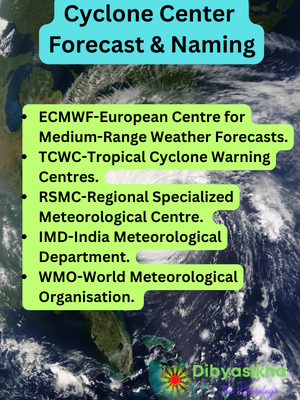
Table of Contents
Cyclone Asani
India prepares for first cyclone of 2022. Cyclone “Asani” is set to form over the Bay of Bengal on Monday. Rescue teams are on high alert amid warnings of heavy rain over Andaman and Nicobar Islands
World Cyclone and Meteorological Centers
- ECMWF–European Centre for Medium-Range Weather Forecasts. Most European countries sponsor the European Centre for Medium-Range Weather Forecasts, which is an autonomous intergovernmental organisation. It has three locations: Shinfield Park in Reading, England; Bologna, Italy; and Bonn, Germany. Headquarter in United Kingdom and founded in the year 1975.
- TCWC–Tropical Cyclone Warning Centres. Area Cyclone Warning Centres (ACWCs) in Calcutta, Chennai, and Mumbai, as well as Cyclone Warning Centres (CWCs) in Vishakhapatnam, Bhubaneshwar, and Ahmedabad, give cyclone alerts.
- RSMC–Regional Specialized Meteorological Centre. It is responsible for disseminating information, advisories, and warnings related to the specific programme they are a part of, as established by consensus at the World Meteorological Organization as part of the World Weather Watch.
- IMD-India Meteorological Department. In 1875, the India Meteorological Department was created. It is the country’s National Meteorological Service and the primary government agency for all topics concerning meteorology and related subjects.
- WMO-World Meteorological Organisation. The World Meteorological Organization (WMO) maintains a list of names that are appropriate for each Tropical Cyclone basin. A cyclone’s name is retired and replaced by another if it is extremely deadly or costly.
How Cyclones are named?
- The word ‘Cyclone’ comes from the Greek word ‘Cyclos,’ which meaning ‘Snake Coils.’ In the Northern and Southern Hemispheres, a cyclone is a violent swirl in the atmosphere with very strong winds circulating around it in an anti-clockwise and clockwise direction, respectively.
- In general, tropical cyclones are named according to the rules at regional level. In the Atlantic and in the Southern hemisphere (Indian ocean and South Pacific), tropical cyclones receive names in alphabetical order, and women and men’s names are alternated.
- When a cyclone reaches a speed of more than 34 nautical miles per hour, it is required to give it a unique name. When a storm hits or exceeds 74 mph, it is categorised as a hurricane, cyclone, or typhoon.
What is a cyclone?
The word ‘Cyclone’ comes from the Greek word ‘Cyclos,’ which meaning ‘Snake Coils.’ In the Northern and Southern Hemispheres, a cyclone is a violent swirl in the atmosphere with very strong winds circulating around it in an anti-clockwise and clockwise direction, respectively.
Classification of Cyclones
The cyclones are classified on the basis of the following:
- Low-Pressure Area: Less than 17 knots ( < 31 kmph)
- Depression: 17 to 27 knots ( 31 to 49 kmph)
- Deep Depression: 28 to 33 knots ( 50 to 61 kmph)
- Cyclonic Storm: 34 to 47 knots ( 62 to 88 kmph)
- Severe Cyclonic Storm: 48 to 63 knots ( 89 to 118 kmph)
- Very Severe Cyclonic Storm: 64 to 119 knots ( 119 to 221 kmph)
- Super Cyclonic Storm: 120 knots and above ( 222 kmph and above)
Read also..
- YouTube Video Thumbnail: Very easy to Set / Add on Mobile.
- UAN, e-Nomination, Claims and Death Settlement of EPF Member.
- Chrome privacy error-your connection is not private.
- Steps to remove Youtube Strike.
- How to Check and Block Spam Messages, Mail and Call.
- Easy way to earn money online.
- How to remove excess ice from freezer.
- Gmail access.
- How i know that my post is indexed or not.
If you liked our article, you can comment on it in the comments box below and also share this post with your friends.
Subscribe so that we will bring you more such articles in the future. Thank you.
Have a good day. God Bless You.




